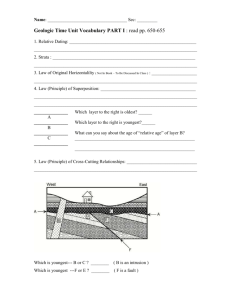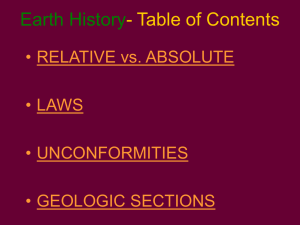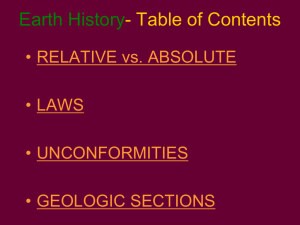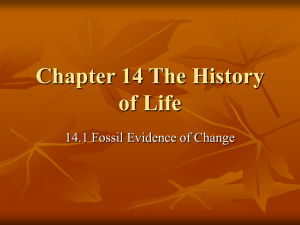ppt
advertisement
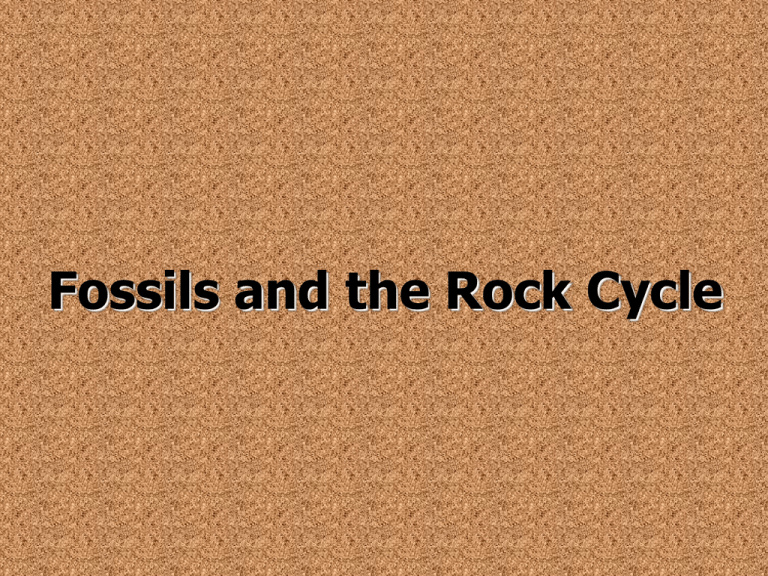
Fossils and the Rock Cycle h ^ The rock cycle explains how one type of rock can be transformed into another in nature. The Geologic Cycle 3 key events: deposition, uplift, erosion Deposition or Sedimentation Uplift Erosion Erosion by wind Erosion by water Geologic Cycle Cycle repeats over and over through geologic time Forms Strata: layers of rock The rock cycle explains how one type of rock can be transformed into another in nature. Index Fossils Use fossil layers to date rocks: index fossils Fossils What is a Fossil? Any evidence of past life, including remains, traces, imprints as well as life history artifacts. Examples of artifacts include fossilized bird's nests, bee hives, etc. Mastodon at Wheaton College How Fossils are Formed About 67 million years ago -- A Tyrannosaurus rex died and its body was quickly covered by riverbed sand and mud. Over time, pressure and some remineralization turned its bones to fossils. The Fossil Record • All of the fossils that have existed throughout life’s history, whether they have been found or not. Tully Monster; IL State Fossil Fossils Usually found in sedimentary rock Sometimes in metamorphic rock These are often distorted, hard to interpret Upper layers - younger Deeper layers – older Principle of Fossil Succession There is a unique, nonrepeating pattern (history) of fossils through stratigraphic time. All rocks containing fossils of the same species were deposited during the duration of that species on Earth. Correlation by fossils. Certain index fossils are keys to matching sedimentary strata in widely separated outcrops Used in conjunction with radioisotope techniques to age rock layers Unconformities Unconformity: contact between layers of rock that should not touch; represents a gap in the fossil/geological record Layers of sandstone over pink granite Hutton's unconformity at Siccar Point Berwickshire, Scotland This was the very first (1789) example of an unconformity Hutton's unconformity Ordovician/Silurian unconformity in New York state Precambrian/Cambrian unconformity near St. Louis – 1 billion years is missing Unconformities Disconformity: gap in geological record Caused by long period of erosion between episodes of sedimentation Or by faulting and uplift Fossils in the two layers may be very different Unconformity of Cambrian sandstone on Precambrian gneiss. North of Kingston, Ontario, Canada. Unconformities Disconformity: missing strata between layers that are parallel to each other. Often difficult to detect in the field. Must use fossils or other correlation methods. Angular unconformity: younger strata overlie an erosion surface on tilted or folded rocks. Implies a specific sequence of events. Nonconformity: contact with overlying sedimentary rocks on top of an erosion surface of plutonic or metamorphic rocks. Implies long-lived erosion prior to burial and re-deposition. Angular Unconformity Nonconformity Angular Nonconformity Angular Unconformity Nonconformity Great Lakes Lost Interval Mesozoic Era Very recent glacial sediments above ancient bedrock Due to long period of erosion of uplifted sediments Big gap in fossil record
